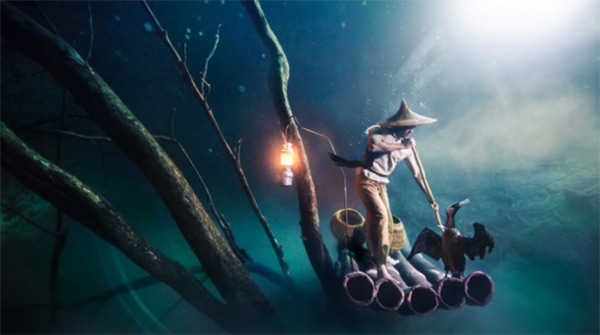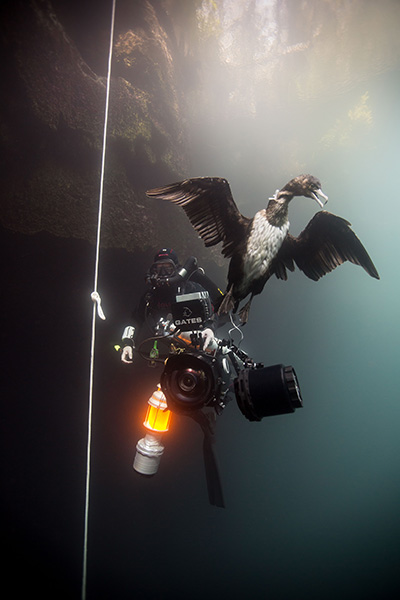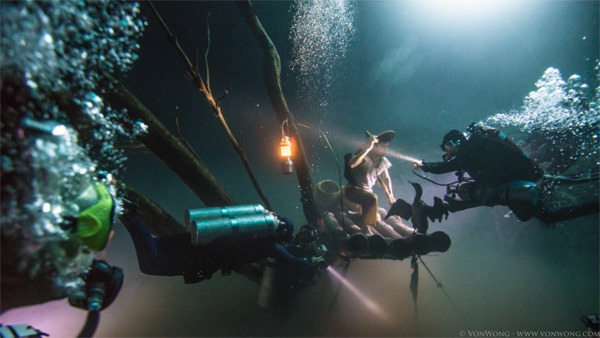Interview: Benjamin Von Wong - Underwater river image

Benjamin Von Wong has become an internet photography phenom with his viral images, including some taken underwater. Earlier this month he released his latest photograph, Underwater River, that took him and his team 30m below the surface into a cenote, just above an underwater river of hydrogen sulfide. Here is Wetpixel’s exclusive interview with Von Wong to find out how he got the shot.
Interview
Wetpixel: The underwater river image is part of Ballantine’s Stay True series. How did you come up with the concept of the image?
I had this grand idea: To recreate the iconic scene of a young Chinese cormorant fisherman hard at work on a bamboo raft – shot 30 meters underwater in a cenote just above a toxic layer of hydrogen sulfide.
Traditional culture as a whole, is something that is inexorably fading with time. I wanted to create a piece that would immortalize a piece of my own culture – the iconic cormorant fisherman. By placing him directly above an underwater river, within this portal that was believed to lead to the Mayan underworld, seemed like the perfect way to bid farewell to a proud tradition.
I guess on a more practical level, I first hear of the underwater river from facebook. At one point this underwater river thing went viral and I just thought that if ever I had the resources, I would love to do something with it.
Wetpixel: How many people were involved with the project?
Well these are the credits… Behind the scenes, and at the scenes though is a really rough number. I’m not quite certain I know how to count them but overall there were definitely 20-some individuals but we were doing more than just a photo - there was a video of the shoot and a behind the scenes too to account for that greatly increased the team size.
Photographer: VonWong Partner: Ballantine’s Scotch Whisky Agency: M&C Saatchi Sport & Entertainment Model: Lance Lee Davis Production: Paz Parasmand and Adam Booth, Archer’s Mark, Yucatan Productions Video Director: William Williamson Surface Camera: Will Hanke Underwater DOP: Rob Franklin Rigging/Support/Safety Divers: Kat Brown, Jack Stevenson, Xibalba Dive Center Photo Assist: Geena M. Grim

Wetpixel: How much planning did it take prior to the shoot day? How involved were you with the planning and execution of technical divers?
All things said and done the shoot was put together in a month from start to finish.
On site, we spent 3 days prepping the shoot, and a day and a half actually doing the shoot.
I had more of a consultation role than an implementation role with the technical divers. Safety was our number one priority.
Wetpixel: The lighting at that depth must have been tricky, what did you use? Did you use strobes at all?
We didn’t use any strobes but did use underwater continuous lamps.
To make that possible, Rob and his team had to first figure out where the lights had to be underwater, and how that translated relative to the surface so that they could align the lights, cables and generator properly. This meant diving down, securing a rope where we imagined the set would be and floating a buoy straight up to the surface.
Using that as a guide, 6x Orca Lights attached to a cheap plexiglass frame were then deployed straight from the surface – to approximately a 70 foot depth – just out of frame of my theoretical shot.
Since underwater gas lanterns don’t exist, we made our own by putting an orange gel inside a vintage lantern which we then duct-taped to a battery powered dive torch.
Last but not least, 2x additional Orca Lights were kept on batteries and handled by Kat, who would act as a mobile light source that could then be directed.

Wetpixel: What were the concerns with working so close to the hydrogen sulfide layer?
Hydrogen Suflide can be absorbed into the skin and cause a whole series of problems. I’m not a doctor but Wikipedia has a pretty awesome article on the health risks! To combat the danger, we minimized the amount of time we would spend inside of it. Your vision drops the minute you pass through it and you can taste it in your regulator so you know when you’re somewhere you don’t want to be.
Wetpixel: How long did Lance Lee Davis need to hold his breath and poses for underwater? Was there any advanced planning for poses?
Well, Lance was driving the shoot holding his breath for as long as possible. It varied but generally revolved around the minute and a half mark. We definitely planned poses:
Lance would dive down, escorted by two safety divers ensuring that air was only a couple seconds away when he would need it. Simple hand gestures and an underwater dive slate were used to communicate with lighting and crew whilst Rich, my safety diver, hovered an arms reach away, keeping a close eye on me and helping me manage my buoyancy so that I could focus on directing and shooting. With only 20 minutes of shooting time underwater and 2 minute breathing-cycles for Lance, the shoot was frenetic and fast paced with little room for waiting around.
As I frantically clicked the shutter on my Nauticam housing, Lance went through a sequence of pre-practiced poses:
Staff Up. Staff Down. Crouch Down. Stand up. Look Down. Look Right. Fix Hat. Repeat.
With each breathing cycle, we refined the poses, tweaked the position of the props and just like that….. it was over.
Wetpixel: What was the most enjoyable part of the project?
I think the most enjoyable part of the project is hitting the publish button. It is at that point where all the hours of hard work and trepidation finally get released and you just hold your breath and hope that it all went gloriously!
Wetpixel: Canon, Nikon, or both (or something else entirely)?
Nikon D800 - 14-24mm lens. EXIF data is in the description of each photo.
Wetpixel: How did you manage to make photography your profession? What advice would you give to people wanting to emulate your career now?
Some Luck. Some Faith. Lots of hard work.
I think you need to do what you love, and not be scared to work to get there. Being an artist is scary at times, but so long as you keep at it, work smart… I think that you can make it!